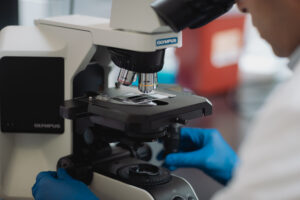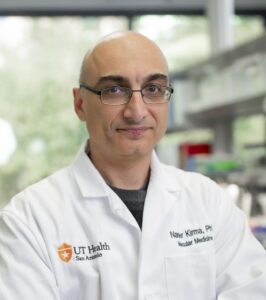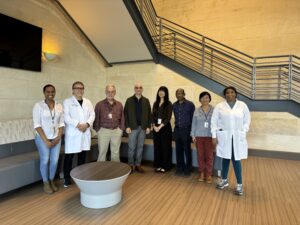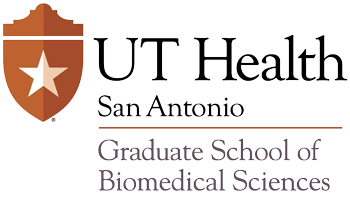From Discovery to Diagnosis: How UT San Antonio Researchers Are Transforming Endometriosis Care

In November 2024, Forbes Magazine featured Hera Biotech in an article titled “No More Invasive Tests: Hera Biotech’s Endometriosis Solution,” spotlighting a team working to change how one of the most misunderstood women’s health issues. Among the company’s founders were two of UT San Antonio’s GSBS faculty mentors, Dr. Nameer Kirma and Dr. Bruce Nicholson.
Hera Biotech represents how UT San Antonio research is moving beyond the bench and into the clinic, bridging scientific discovery with real-world impact.
A Personal Reflection from the Author of this Article
Over a year ago, around the time the Forbes article was published, I began my own medical journey. After years of unexplained pain, I finally underwent the only readily available diagnostic and treatment option for endometriosis, laparoscopic surgery. For years, I delayed the procedure, doubting my symptoms and fearing it would be a waste of time and money.
At the urging of a friend, I pursued an enhanced laparoscopic technique, a laser excision performed with a robotic surgical system. The results were both illuminating and life-altering. The pain I had felt since I was sixteen, often dismissed as “normal,” was finally given a name: Stage 4 endometriosis. Surgeons removed a large cyst and a benign tumor, and I later began IVF treatments to address its impact on my fertility.
Had I received a diagnosis sooner, I could have been spared years of pain and uncertainty, and had more fertility options. This experience reinforced what so many women already know too well; delayed diagnosis has real and lasting consequences.
It is precisely this problem, diagnostic delay, that researchers, including several of our own Graduate School of Biomedical Sciences (GSBS) students at UT San Antonio, are determined to solve.
A Silent Disease
Endometriosis is a leading cause of infertility and chronic pain in women, caused by the growth of endometrial tissue, normally found lining the uterus, in other parts of the body, such as the abdominal cavity. Despite affecting one in ten women globally, research investment in understanding its causes has been limited (1/65th per capita compared to research on irritable bowel syndrome, 1/30th of that on breast cancer), making it one of the clearest examples of health disparities in women’s medicine.
Because symptoms often mimic other disorders like gastrointestinal or pelvic conditions, endometriosis is frequently misdiagnosed. On average, patients wait seven years before receiving an accurate diagnosis, which has historically required surgical confirmation. Even then, treatment options remain limited to symptom management or surgical excision of lesions, procedures that are costly and offer only temporary relief, as the lesions return.
Innovation in the Lab

Dr. Nameer Kirma, Associate Professor, Department of Molecular Medicine at UT San Antonio
In their shared pursuit to make diagnosis faster and less invasive, the Kirma and Nicholson research labs began exploring molecular markers of endometriosis. Together, their teams developed a single-cell diagnostic method that provides high-resolution molecular analysis of the uterine lining. Dr. Kirma noted, “The only reliable diagnosis once required surgery. A gene-based diagnostic has the potential to be truly game-changing.”
By examining individual cells from the endometrium, they identified a distinct gene fingerprint that differentiates tissue from women with endometriosis from those without the disease. The panel focuses on genes that regulate intercellular communication, which appear to be altered in endometriosis. These findings show that such communication changes directly contribute to the tissue’s invasive behavior and may help explain the high rates of infertility observed in affected women.
This discovery laid the foundation for Hera Biotech’s diagnostic technology, designed to replace surgical confirmation with a minimally invasive brush biopsy, a procedure similar to a Pap smear. If brought to clinical scale, this innovation could make early diagnosis quicker, more precise, and easier to access. Data is promising. with an initial clinical trial of over 60 patients yielding ~88% accuracy in diagnosis.
Clinical Application

Dr. Bruce Nicholson, Professor of Biochemistry and Structural Biology and Co-Director of the Center for Innovative Drug Discovery
Translating laboratory discoveries into real-world medical solutions is rarely straightforward. The current gold standard for diagnosis and treatment, laparoscopic surgery, is both invasive and costly. While the team’s brush biopsy method represents a major step forward, their long-term goal is even more ambitious: developing a non-invasive test that can be performed directly in OB/GYN offices. Dr. Nicholson emphasized, “To be fully effective, diagnostics must reach the clinic in practical, affordable forms.”
Towards this end, the UT San Antonio team has worked on simplifying the assay system, showing that bulk PCR, which is commonly available in all diagnostic labs, can also effectively distinguish endometriosis patients. They are also exploring whether endometrial tissue from menstrual flow could serve as a viable source, an advance that could revolutionize accessibility and early detection. Together, these advances could make early detection more accessible with no invasive processes, reducing the need for surgical confirmation.
Graduate Students Driving Discovery
Graduate students in Drs. Nicholson and Kirma’s labs have been instrumental in decoding the molecular and cellular pathways that are disrupted in the endometrium, leading to the survival of this tissue in the peritoneum and its ability to invade and form lesions in the abdominal cavity. Their findings have been central to understanding how these cellular disruptions contribute to both infertility and chronic inflammation, which is key to shaping the next generation of diagnostics and potential therapeutics.
According to the researchers, the most effective diagnostics, as well as the most promising therapeutic pathways, require a strong understanding of the molecular mechanisms behind disease pathophysiology. That’s why so many innovative strategies originate in academic settings, where students and mentors can collaboratively explore fundamental biology while developing real-world applications.
Through the Integrated Biomedical Sciences (IBMS) program, these students are helping uncover the complex mechanisms that drive endometriosis at its roots. Their work underscores an essential truth: the most effective diagnostics, and the most promising pathways to developing future treatments, depend on a deep understanding of the disease’s underlying molecular mechanisms and pathophysiology.

Group photo with members of the Kirma and Nicholson Labs
These contributions extend far beyond academic exercise. Graduate students are generating the mechanistic insights that underpin the accuracy of the diagnostic methods and lay the groundwork for the first targeted therapeutic approaches for endometriosis. Indeed, the Nicholson lab is now exploring the first in-kind small molecule therapeutic that shows great promise in preventing the initial formation of endometriosis lesions, thus moving beyond management of symptoms to stopping the disease at its origin. These discoveries were only possible through investments by our institution’s state-of-the art core facilities like the Center for Innovative Drug Discovery (founded by Dr Nicholson) that produced and identified the small molecules, and the Bioanalytics and Single Cell Core facility (Directed by Dr. Kirma) that drove all of the initial diagnostic efforts
This collaboration between a University’s vision in establishing infrastructure to support cutting edge research, dedicated faculty mentors and emerging scientists in training embodies the translational mission of UT San Antonio’s Graduate School of Biomedical Sciences, connecting curiosity with clinical impact and empowering students to lead discovery that directly benefits patients.
Lab Culture: Fostering Mentoring and Collaboration
Drs. Kirma and Nicholson attribute their lab’s success to a culture grounded in communication, curiosity, and independent inquiry. Students are encouraged not only to master techniques, but also to challenge assumptions, engage deeply with current literature, and develop their own scientific questions.
This two-way mentorship model accelerates discovery while preparing future scientists to lead research efforts that are both rigorous and responsive to patient needs. It’s an approach that fosters resilience, creativity, and the confidence to ask, and answer, the hard questions.
Advice for Emerging Innovators
For aspiring researchers and entrepreneurs, both faculty members emphasize the importance of staying grounded in both science and practicality. Translational breakthroughs, they note, are most sustainable when rooted in a deep understanding of biology and paired with awareness of real-world challenges such as funding, regulation, and commercialization.
They shared, “The more diagnostic and therapeutic approaches are steeped in a genuine understanding of the underlying pathophysiology and biochemistry, the more robust will be the translational products, and the higher likelihood they will end up in patients.” They remind future scientists that there are no shortcuts in translational research. True innovation comes from persistence, collaboration, and a willingness to bridge disciplines.
Research with Impact
The story of Hera Biotech and the UT San Antonio laboratories that inspired it reflects a broader truth: basic science is the foundation of medical progress. From decoding the molecular language of the endometrium to developing accessible diagnostic tools and ultimately therapies that will directly impact patient lives, this research represents a tangible step toward equity in women’s health.
As someone who has lived through the long journey to diagnosis, I understand the difference this kind of innovation can make. Early, accessible, and accurate diagnostics don’t just change medical outcomes, they change lives.
Endometriosis may be a centuries-old condition, but through innovation, mentorship, and perseverance, UT San Antonio mentors and graduate students are proving that its future can, and will, look very different.
Written By: Amanda Ramirez, PhD
